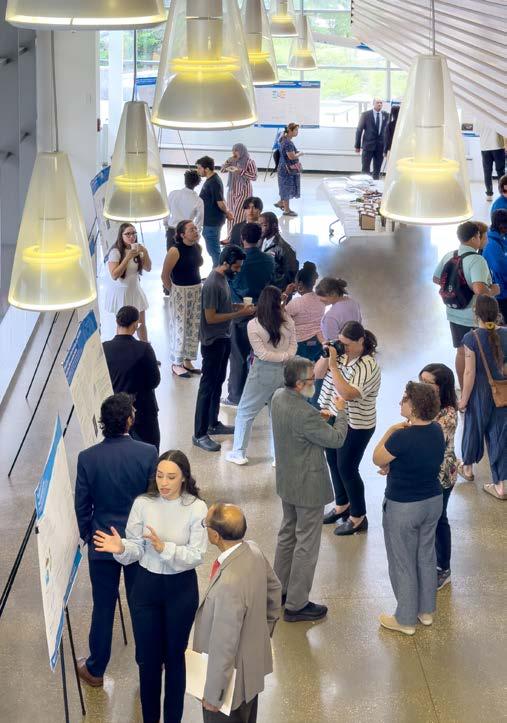


























When dynamic research is activated through entrepreneurial collaborations, groundbreaking discoveries create real-world impacts. At UB, partnerships empower research and investments in innovation propel companies like Abceutics Inc.—a biopharmaceutical startup that emerged from the lab of UB faculty member Joseph Balthasar and his colleagues to gain national prominence by realizing life-saving technology.
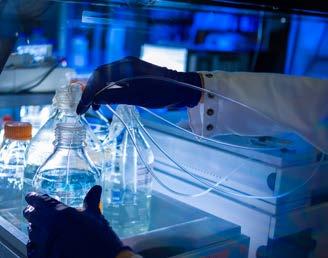
UB-born cancer therapy startup acquired by Merck for up to $208 million in potential consideration.
By Laurie Kaiser
Published April 5, 2024
Read the full article:
Read the complete Abceutics Inc. case study:
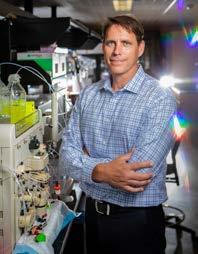
UB startup Abceutics Inc. acquired by Merck
Abceutics Inc., a startup preclinical-stage biopharmaceutical company that was spun out of the laboratory of UB researcher Joseph P. Balthasar, was acquired by the global biopharmaceutical company Merck, known as MSD outside the U.S. and Canada.
Merck acquired Abceutics for a potential consideration of up to $208 million, including contingent milestone payments based upon the progress of candidates under the agreement. Balthasar, the David and Jane Chu Endowed Chair in Drug Discovery and Development in the Department of Pharmaceutical Sciences, launched the startup in 2020.
The company’s core technology, licensed from UB, was developed through National Institutes of Health (NIH) grants and $110,000 from the Buffalo Innovation Accelerator Fund, which is operated by UB’s Business and Entrepreneur Partnerships office.
Abceutics has operated out of incubator space in UB’s New York State Center of Excellence in Bioinformatics and Life Sciences, which also provided the company $50,000 from Empire State Development’s Division of Science, Technology and Innovation. The company also participated in UB’s National Science Foundation (NSF) Innovation Corps program.
Co-founders included Brandon Bordeau and Toan Duc Nguyen, former students of the Balthasar lab, and Larry Wienkers, a pharmaceutical consultant. Bordeau, now at the University of Michigan, served as the startup’s CEO.
The work of Abceutics is synergistic with an important emerging class of medicines called antibody-drug conjugates (ADCs). ADCs combine a monoclonal antibody with a cytotoxic payload. The antibody component of an anticancer ADC specifically targets the medicine to particular cancer cells, and the cytotoxic payload uses highly potent cell-killing properties to then kill the targeted cancer cells.
The team engineered “payload-binding selectivity enhancers” (PBSEs) to bind and neutralize stray payload molecules, reducing the impact of these agents on otherwise healthy cells.
David Weinstock, VP of oncology discovery in Merck Research Laboratories, highlights Abceutics’ success. “The Abceutics team has already made remarkable progress in translating this novel idea into reality with a series of candidates and compelling early evidence,” he says. “We look forward to further evaluating the potential of this innovative approach in the clinic.”
Bordeau says the team is excited for Merck to continue to explore and develop the PBSE technology. “Merck is recognized as a leader in cancer research and has the expertise and capabilities needed to bring our PBSE technology to patients,” Bordeau says. “We are proud to have advanced PBSEs to this stage of development and believe that Merck is well-suited to build upon the progress our company has made.”
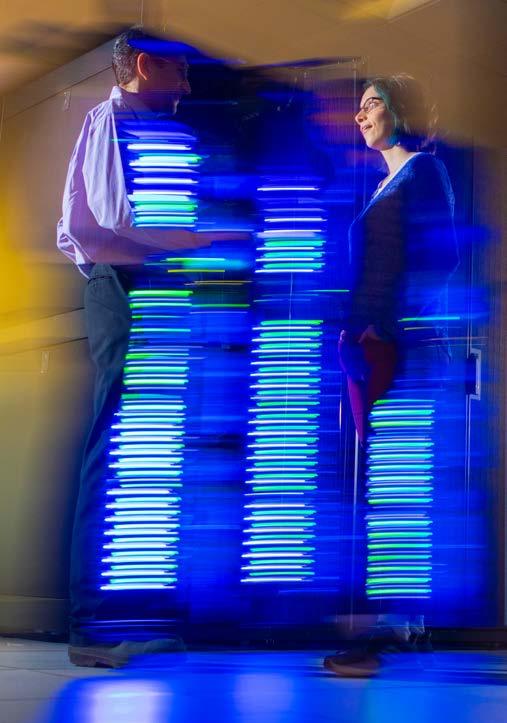


UB awarded $10 million grant to lead new national center on early literacy and responsible AI
UB researchers have been awarded a $10 million grant from the U.S. Department of Education’s Institute of Education Sciences to establish the Center for Early Literacy and Responsible AI (CELaRAI).
CELaRAI will focus on harnessing the power of artificial intelligence which will transform beginner reading and writing instruction for historically underrepresented students in K-2 classrooms across the nation.
Led by X. Christine Wang, the Center for Early Literacy and Responsible AI aims to address a critical need to improve beginning reading skills of students, with an emphasis on students from underrepresented and underserved communities. According to the National Assessment of Educational Progress, only 33% of fourth-graders achieved proficiency in reading comprehension in the U.S. in 2022, a shortfall predominantly affecting low-income, Black, Latinx and other marginalized students.

Christine Wang, PhD Professor and Senior Associate Dean for Research, Department of Learning and Instruction, Graduate School of Education; Director, Fisher-Price Endowed Early Childhood Research Center
By Vicky Santos
Published September 19, 2024
Read the full article:
Learn more about the Center for Early Literacy and Responsible AI:
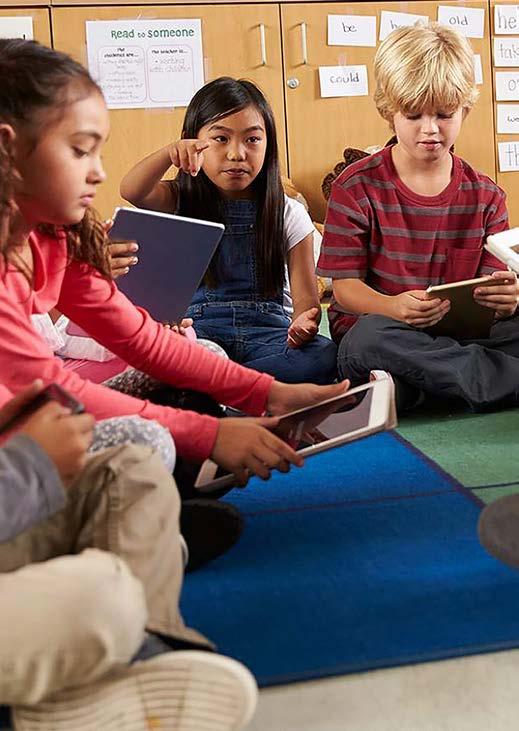

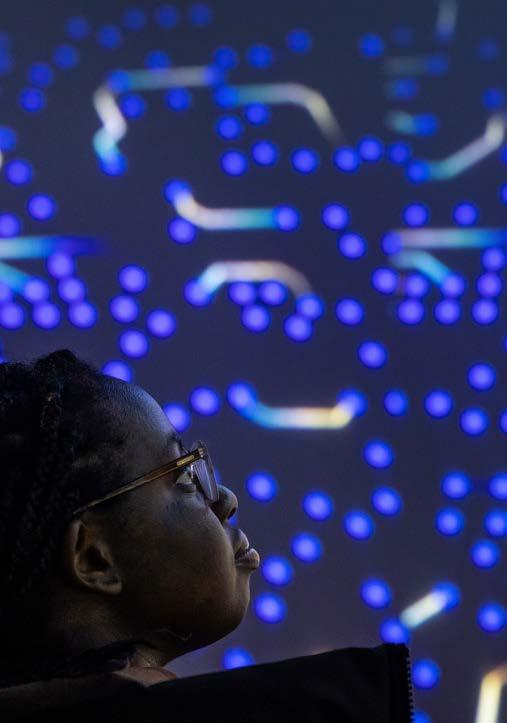


AI could remediate future power outages, study finds
UB researchers have developed an artificial intelligence model designed to remediate power outages by automatically rerouting electricity in milliseconds.
The UB researchers, who collaborated with engineers at the University of Texas at Dallas, demonstrated the automated system in a research article published online June 4 in Nature Communications
The approach is an early example of “self-healing grid” technology, which uses AI to detect and repair problems such as outages autonomously and without human intervention when issues occur, such as storm-damaged power lines.
Using test network scenarios, the team showed its solution can identify alternate electricity routes before an outage occurs. Once trained, AI can reroute electricity in microseconds, versus minutes or hours using classical techniques.
While further research is needed before the system can be implemented and scaled to real-world power grids, it is nonetheless an exciting development for the nation’s beleaguered power grid, researchers say.
The work was supported by the U.S. Office of Naval Research and the National Science Foundation.
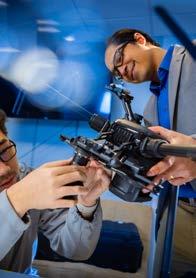
Souma Chowdhury, PhD Associate Professor, Department of Mechanical and Aerospace Engineering; Adjunct Associate Professor, Department of Computer Science and Engineering, School of Engineering and Applied Sciences
By Cory Nealon and Kim Horner
Published June 28, 2024
Read the full article:
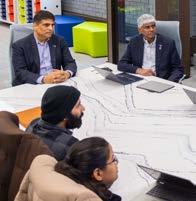
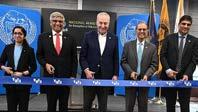
Top Left: Venu Govindaraju, PhD, vice president for research and economic development and director and principal investigator for the National AI Institute for Exceptional Education (NAI4EE), and Srirangaraj (Ranga) Setlur, associate director of community engagement for the Institute for Artificial Intelligence and Data Science (IAD).
Photo: Douglas Levere
Bottom Left: Preparing to cut the ribbon to open the NAI4EE are (from left) Sahana Rangasrinivasan, a computer science and engineering PhD candidate; NSF Director Sethuraman Panchanathan; U.S. Senate Majority Leader Chuck Schumer; President Satish K. Tripathi and Venu Govindaraju, vice president for research and economic development, and principal investigator of the AI institute.
Photo: Nancy J. Parisi
At Right: Jinjun Xiong, PhD, director, Institute for Artificial Intelligence and Data Science and SUNY Empire Innovation Professor in the Department of Computer Science and Engineering, School of Engineering and Applied Sciences, collaborating with students.
Photo: Douglas Levere
Ribbon cutting for the National AI Institute for Exceptional Education
In January 2023, the National Science Foundation announced that UB was awarded $20 million from the National Science Foundation and the Department of Education’s Institute of Education Sciences, to create the National AI Institute for Exceptional Education. At this UB-led institute, researchers from nine partner universities are developing artificial intelligence systems to identify and assist young learners with communications and language challenges, addressing the nationwide shortage of speech-language pathologists.
In April 2024, UB hosted Senate Majority Leader Charles Schumer and National Science Foundation Director Sethuraman Panchanathan for the ribbon cutting, celebrating the opening of the 3,000-square-foot institute on UB’s North Campus.
By Cory Nealon
Published April 2, 2024
Read the full article:
Learn about the National AI Institute for Exceptional Education:
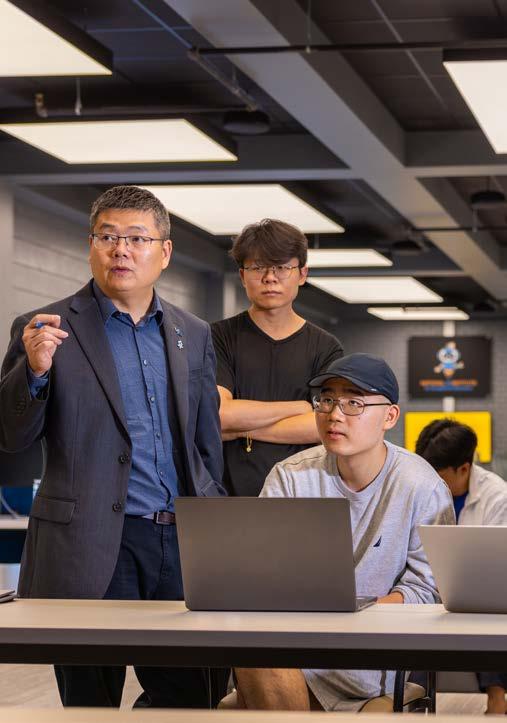

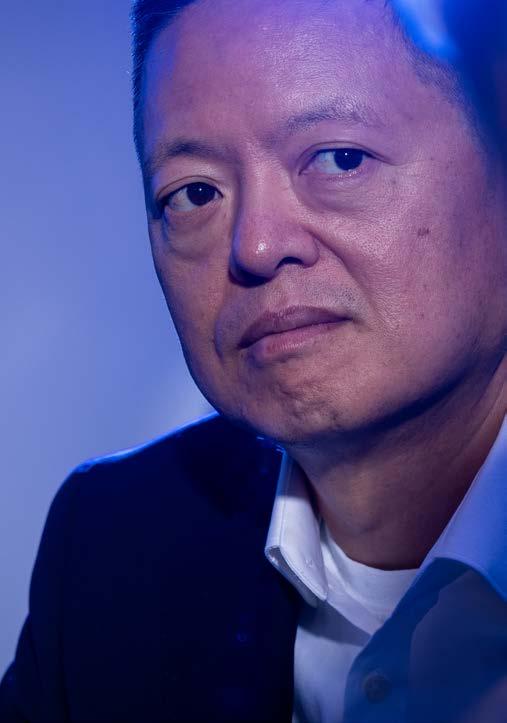

Deepfake detection for all
When misleading information spreads online, it can spread fast.
Yet many of the best tools for swiftly debunking viral photographs, videos and audio are only available to researchers, like UB deepfake expert Siwei Lyu.
“Everyone from social media users to journalists to law enforcement often has to go through someone like me to figure out if a piece of media shows signs of being generated by artificial intelligence,” says Lyu, who routinely obliges such requests.
“They can’t get an immediate and conclusive analysis when time is of the essence.”
That’s why Lyu and his team at the UB Media Forensics Lab developed the DeepFake-o-Meter, which combines several state-of-the-art, deepfake-detection algorithms into one open-source, web-based platform. All users need to do is sign up for a free account and upload a media file. Results typically come back in less than a minute.
To date, there have been thousands of submissions to the platform. Media outlets used it to analyze various AI-generated content, from a Joe Biden robocall telling New Hampshire residents not to vote to a video of Ukrainian President Volodymyr Zelenskiy surrendering to Russia.

Siwei Lyu, PhD
SUNY Empire Innovation Professor, Department of Computer Science and Engineering, School of Engineering and Applied Sciences; Co-Director, Center for Information Integrity
“The goal is to bridge the gap between the public and the research community,” says Lyu, SUNY Empire Innovation Professor in the Department of Computer Science and Engineering, School of Engineering and Applied Sciences. “Bringing social media users and researchers together is crucial to solving many of the problems posed by deepfakes.”
The DeepFake-o-Meter is supported by the National Science Foundation and the UB Office of the Vice President for Research and Economic Development.
By Tom Dinki
Published September 16, 2024
Read the full article:
Experience the DeepFake-o-Meter:
Mind over matter
For individuals with severe paralysis, functional independence can seem like an impossible dream. But in the age of AI, it’s not just possible— it’s becoming reality.
One of the more exciting developments is neurotechnology company Synchron’s endovascular brain-computer interface—minimally invasive, maximally powerful—designed to allow someone with limited to no mobility control personal devices, like a cellphone or computer, with their thoughts.
The interface is implanted within the motor cortex of the brain through a minimally invasive endovascular procedure. Once implanted, it can detect and wirelessly transmit intended movement patterns as digital commands through a technology called “digital motor output,” effectively enabling severely paralyzed people to control their devices with their intentions, said Elad Levy, L. Nelson Hopkins Endowed Chair of Neurosurgery at the Jacobs School of Medicine and Biomedical Sciences at the University at Buffalo and a principal investigator on the study.
Two of the six patients in the study were enrolled at the Gates Vascular Institute (GVI) in Buffalo— a natural choice, said Levy, for Synchron to make.
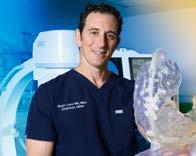
“Our group at UB and the GVI has been in the forefront of learning how to navigate complex devices in the venous system of the brain,” he said.
The neurosurgeons were assisted by a third Buffalo partner, the Jacobs Institute, a vascular and neurologic medical device innovation center.
Levy presented the results of the trial to the Congress of Neurological Surgeons in September of 2024, which in turn awarded him the Duke Samson Award, recognizing the best clinical paper addressing a topic of cerebrovascular surgery.
In addition to bringing people with severe paralysis one step closer to functional independence, said Levy, the trial provided invaluable lessons for the team that planned and developed the procedure, including residents and fellows at UB.
By Ellen Goldbaum
Read the full article:
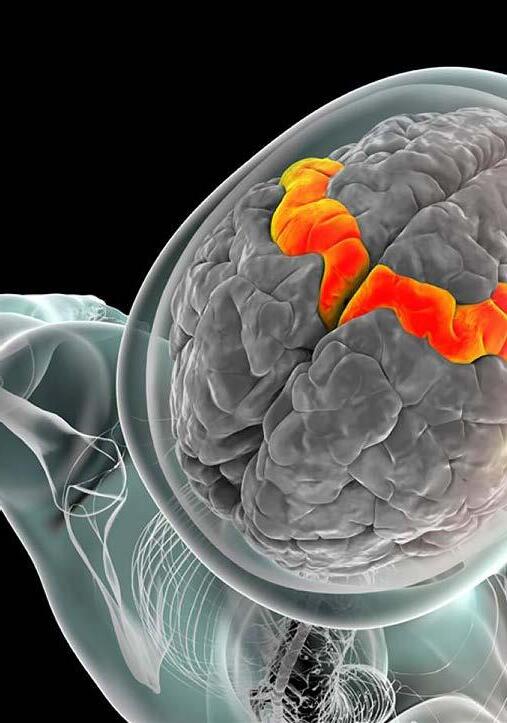



Seawall baffles—and AI—help emerald shiners swim to Lake Erie
UB researchers are looking down at a 24-foot-long flume of shallow, running water. Inside, about a dozen emerald shiner minnows are furiously attempting to swim against the current.
It’s not going well for the shiners. These tiny prey fish have sustained swim speeds of about 0.4 meters per second—with burst speeds up to double that— but the flume’s current is running at about 0.4 meters per second, so, despite all their effort, the shiners swim to remain in place.
Yet some force starts to bring these disparate fish together. A group of two joins a group of eight, which then joins up with another group of four. Only once all 14 shiners in the flume are swimming together in tight formation do they finally begin to move upstream.
Video of this experiment will be fed into artificial intelligence tools that can track the movement of individual fish, as well as the velocity of the water.
This kind of data was the basis for construction of an unconfined fishway along the seawall at Buffalo’s Freedom Park, located near the Peace Bridge, in 2022. Ten steel, trapezoid-shaped baffles attached to the wall slow the Niagara River’s velocity to allow emerald shiners to swim more easily upstream to Lake Erie, where they contribute to the health of the
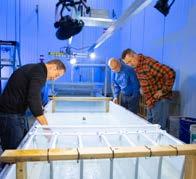
Sean Bennett, PhD (Professor, Department of Geography and Associate Dean, College of Arts and Sciences) and his colleagues use an overhead video camera and an object-detection model to track the shiners’ movements, as well as the water velocity, inside the flume.
Photo: Douglas Levere
ecosystem, including threatened birds and sport fish. These results were described in a study published earlier this year in Ecological Engineering
Now, the U.S. Army Corps of Engineers is preparing to place baffles on the remaining 700 feet of seawall.
In addition to helping wild emerald shiners and the rest of the Niagara River ecosystem, UB researchers’ ongoing experiments with the flume and AI can shed light on fundamental aspects of all fish behavior.
“We’re trying to understand what determines a fish moving from Point A to Point B. Is it responding to the flow velocity or turbulence? Or is it responding to something else?” says Sean Bennett, professor in the Department of Geography and associate dean, College of Arts and Sciences.
By Tom Dinki
Published June 24, 2024
Read the full article:
With state budget deal reached, UB ready to help launch Empire AI
In January 2024, New York State Governor Kathy Hochul proposed Empire AI as a consortium comprised of public and private higher education institutions statewide with the goal of accelerating research and innovation in AI, while driving sustained economic impact across the state.
Equally important is its mission to tackle societal challenges in medicine, education, social justice, climate change and other fields, while also serving as a trustworthy source of information as AI technologies continue to evolve.
In addition to UB and fellow SUNY University Centers—the University at Albany, Binghamton University and Stony Brook University—the new consortium is comprised of the City University of New York, Columbia University, Cornell University, New York University, Rensselaer Polytechnic Institute, the Flatiron Institute, as well as vital philanthropic backers.
In January, Hochul announced UB as the statewide location for Empire AI in acknowledgment of the university’s decades-long leadership in AI and data science.
The region’s state legislators followed up with a visit to campus in March, when they lauded the governor’s vision for Empire AI and threw their support behind her plan to make UB its home.
A SUNY flagship with a robust cyberinfrastructure, UB has long been recognized nationally and internationally as a leader in AI and data science.
The university has 200 researchers exploring how to use AI and data science to advance cybersecurity, drug discovery, robotics, education, environmental science, transportation and other fields that are critical to the future of the state and nation.
Additionally, UB is No. 1 in the state among public and private research universities in securing cyberinfrastructure program funding from the National Science Foundation (NSF).
In 2023, the university was awarded a highly competitive, five-year, $20 million grant from the NSF and the Department of Education to establish the National AI Institute for Exceptional Education, which brought Senate Majority Leader Chuck Schumer and NSF Director Sethuraman Panchanathan to UB in April 2024.
“University at Buffalo is delighted and honored to be a part of the groundbreaking Empire AI consortium, which will place our region, state and nation at the forefront of the artificial intelligence revolution,” President Satish Tripathi said.
By Jay Rey
Published April 22, 2024
Read the full article:

President Satish K.
and New York State Governor Kathy
gathered with others to announce that Empire AI was installed at the consortium’s temporary site in UB’s Center for Computational Research on the
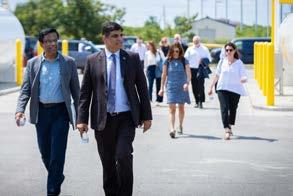

Members of the Empire AI consortium joined UB leaders in July 2024 to tour possible sites on the North Campus for the statewide consortium’s new supercomputing center, which aims to place New York State at the forefront of harnessing artificial intelligence for social good.
Douglas Levere
Empire AI comes online
Empire AI’s proverbial switch has been flipped. As the ceremonial lever pulled by Gov. Kathy Hochul illuminated a sign above, she and other officials lit up about the now-online supercomputing power below their feet.
They announced that the $400 million statewide consortium’s initial computing power has been installed at UB’s Center for Computational Research (CCR) on the Downtown Campus, allowing members to begin harnessing artificial intelligence for the public good this fall, 18 months ahead of schedule and while the larger, permanent supercomputing center is built on the North Campus.
The new computing system, which officials said already represents some of the strongest computing power in the nation, is courtesy of a philanthropic contribution from the Simons Foundation, one of Empire AI’s private partners, and investment from New York State.
“To some, it may just look like a tangle of wires and dark trays with blinking lights, but it’s nothing short of a revolution in the way we learn and work and interact with each other. In fact, it’s like the heart beating in a body with the cadence of advancement and pumping technology and the future through its veins,” Hochul told those gathered for the announcement. “Join me on this journey as we go boldly where AI in New York has never gone before.”
Officials also announced the consortium recently launched a request for proposals (RFPs) for Empire AI’s new supercomputing center to be constructed at UB and has begun receiving bids. Consortium members toured two possible sites on the North Campus in July, including a site located off Service Center Road near the power substation and another off Flint Road near the Chilled Water Plant.
Hochul said she hopes to have the center constructed within 18 months to two years, adding that the facility’s initial footprint may be expanded in the future.
“Because of Gov. Hochul’s visionary leadership, the generosity of the Simons Foundation and the support of the state Legislature, New York State now has the computing power needed to advance artificial intelligence research. Empire AI will put New York State at the epicenter of AI innovation,” said President Satish K. Tripathi. “This game-changing initiative will enable researchers across the consortium to use the power of AI to solve some of our world’s most troubling problems. UB is very proud to be the home of Empire AI.”
Starting fall 2024, Empire AI consortium members will leverage the initial computing at CCR to address major societal challenges, from climate change and food insecurity to drug discovery and educating students with learning disabilities.
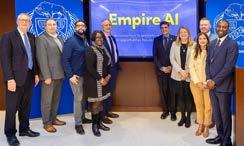
together in praise of Empire AI are
Provost A. Scott Weber; Amherst Supervisor Brian Kulpa; Assembly Member Jon Rivera; Assembly Majority Leader Crystal Peoples-Stokes; Sen. Sean Ryan; Vice President for Research and Economic Development Venu Govindaraju; Assembly Member Karen McMahon; Assembly Member Pat Burke; Marjorie Velázquez, vice president of policy at tech:nyc; and Mo Sumbundu, assistant director at Empire State Development. Photo: Douglas Levere
It’s nothing short of a revolution in the way we learn and work and interact.

Consortium members have already submitted more than 100 responses to Empire AI’s call for proposals, opened earlier this month, officials said. Proposed research includes accelerating basic science in technologies like fusion reaction and microelectronics, as well as building ethical and safe AI models and combating misinformation.
Tom Secunda, another one of Empire AI’s philanthropic backers, praised the work of UB and the Simons Foundation to get the initial computing systems up and running just six months after $275 million in funding for the consortium was included in the state budget.
“Empire AI will not only speed up discovery but create new kinds of discovery, and now that academic institutions have an 18-month head start, we’re that much closer to the next scientific breakthrough,” he said.
SUNY Chancellor John B. King Jr. noted UB’s long history as a leader in AI innovation, including developing the first automated, handwriting-recognition system that has saved the U.S. Postal Service billions of dollars.
“Not if, but when we do this right, AI will be a tool for humans to create a healthier, more sustainable, more active, more inclusive and democratic, and yes, even more entertaining world—a world of extraordinary wonder that I cannot thank you all enough for working to make a reality right here at the University at Buffalo,” King said.
By Tom Dinki
Published October 14, 2024
Read the full article:




Center for Advanced Semiconductor Technologies
UB’s Center for Advanced Semiconductor Technologies brings together researchers across the university to work collaboratively on cutting-edge research in microelectronics while training the next generation of leaders and engineers for the semiconductor industry.
The center enables multi-disciplinary collaborations among researchers to address the increasing energy needs of modern computing and to develop widegapsemiconductors for application in electric vehicles and renewable energy grids. They will also advance the implementation of photovoltaic (solar) technologies to support New York State’s clean-energy goals.
By Madeline Dovi
Published January 8, 2024
Read the full article:
Jonathan Bird serves as center director. Bird proposed the multidisciplinary approach because Buffalo “is a natural fit to catalyze advanced research and development to support the semiconductor industry and enable regional high-tech resources and a ready, STEM workforce.”

UB, partners awarded $40 million to boost semiconductor industry
The Buffalo-Rochester-Syracuse region will receive $40 million for semiconductor manufacturing, research and education, U.S. Senate Majority Leader Charles E. Schumer announced in summer 2024.
The funding is part of the CHIPS Science Act passed by Congress in 2022. In addition to the tri-city region, 11 other metro areas nationwide were awarded $464 million to support technology hubs, which had mostly been limited to large coastal cities.
By Cory Nealon
Published July 3, 2024
Read the full article:
“UB is honored to harness our research and industry partnerships in service of this regional tech hub,” President Satish Tripathi said, adding that it has the potential to “transform our region into a national center for semiconductor manufacturing bolstered by a robust supply chain and workforce.”
The Buffalo-Rochester-Syracuse consortium includes roughly 100 members from across higher education, the public sector, industry, economic and workforce development and labor.
The UB School of Management’s Center for Supply Chain Analytics is leading UB’s involvement in this $40 million initiative to grow semiconductor manufacturing, research and education in New York State through its $9 million Supply Chain Activation Network (SCAN) initiative.



NIH awards UB $28.4 million to build on strong foundation improving health outcomes, addressing disparities through translational science
The National Institutes of Health (NIH) awarded UB $28.4 million over seven years to build on its extensive record of success using the power of research to improve health outcomes and address health disparities throughout Western New York.
The Clinical and Translational Science Award (CTSA) to UB’s Clinical and Translational Science Institute (CTSI), announced January 17, is the third CTSA that UB has received under the NIH’s National Center for Advancing Translational Science program. The first was awarded in 2015; the second in 2020.
The award brings UB’s total CTSA funding since 2015 to just over $65 million.
The purpose of the CTSAs, awarded to only 63 institutions nationwide, is to speed the translation of research discoveries into improved care for all while prioritizing the needs of the most vulnerable members of the community.
“This landmark award reaffirms UB’s stature as a premier public research university that is committed to contributing meaningfully to the health and well-being of the communities we serve,” said President Satish K. Tripathi. “It recognizes both the dramatic progress our UB faculty researchers have made in accelerating critical breakthroughs into enhanced patient care and our enormous potential
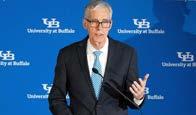
Timothy F. Murphy, SUNY Distinguished Professor, principal investigator and director of UB’s Clinical and Translational Science Institute, announcing UB’s $28.4 million Clinical and Translational Science Award, its third since 2015. Photo: Sandra Kicman
to continue developing cutting-edge innovations and interventions in the interest of a healthier, more equitable society.”
The work of the CTSA is accomplished through close collaborations among researchers throughout UB— including its six health sciences schools and Roswell Park Comprehensive Cancer Center— as well as 15 collaborating institutions and influential community partners, which comprise the Buffalo Translational Consortium.
“This renewal ensures that the health of our community will continue to benefit from these critical collaborations,” said Allison Brashear, vice president for health sciences and dean of the Jacobs School of Medicine and Biomedical Sciences at UB.
“The CTSA renewal grant is a testament to UB’s commitment to advancing medical research and improving lives. By empowering our researchers to investigate the most vexing health challenges, we’re making a tangible difference in Western New York, across the state and around the world.”
By Ellen Goldbaum
Published January 17, 2025
Read the full article:
AI smartphones may help monitor chronic wounds from home
Individuals increasingly can check on their health conditions at home. Devices that measure blood pressure, glucose and blood oxygen levels, for example, enable patients’ providers to make decisions for their care.
In the near future, patients may also be able to monitor their chronic wounds from the comfort of their homes through mobile artificial intelligence (AI) technology being developed at UB.
Wenyao Xu, professor and associate chair of the Department of Computer Science and Engineering, is leading a team that recently was awarded $3 million from the National Institutes of Health for the four-year research project, “Mobile Health Technologies for Assessing Blood Perfusion in Chronic Wounds.”
Approximately 8.2 million Americans suffer from chronic wounds that stem from a multitude of conditions, including diabetes and major surgery. This technology—accessible through a smartphone— will help streamline treatment, Xu says.
“Patients with these conditions frequently visit their health care providers or specialty wound care clinics and, in some cases, need to be hospitalized,” Xu explains. “This can be a financial burden and a time burden to both the patient and the health care system.”
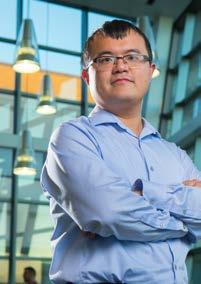
The AI technology analyzes the mobile images and predicts if the wound is on the right track for healing.
Wenyao Xu, PhD Professor and Associate Department Chair, Department of Computer Science and Engineering, School of Engineering and Applied Sciences
By Laurie Kaiser
Published May 1, 2024
Read the full article:
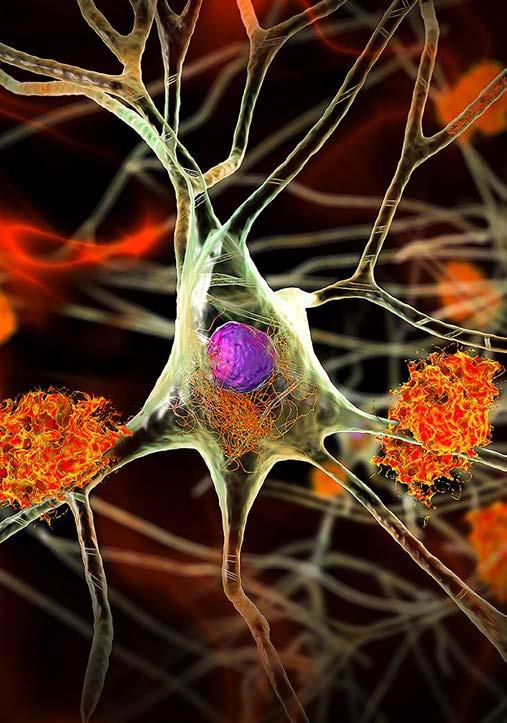

UB professor, NYS researchers developing immunotherapy treatment for Alzheimer’s
Among progressive neurodegenerative diseases, Alzheimer’s is one of the most common and most heartbreaking. It robs individuals of their memories and self-sufficiency and can even alter their personalities.
Nearly seven million Americans over age 65 are living with Alzheimer’s, and that number is projected to nearly double by the year 2050 as the population continues to age.
Jonathan Lovell, SUNY Empire Innovation Professor in the Department of Biomedical Engineering, is developing a novel immunotherapy approach to Alzheimer’s treatment. He leads a research team that is working on a vaccine that targets multiple sites within the key polypeptides of both pathogenic hallmarks of the disease: amyloid-beta (A ) and tau. The immunotherapy concept, which was published in the August issue of the journal Brain, Behavior, and Immunity, suggests that the body can mount an immune response to multiple epitopes of A and tau, which are parts of those proteins that the immune system can recognize.
“What distinguishes our approach is that we’re not just targeting one epitope in Alzheimer’s, we’re targeting multiple ones,” Lovell says. “By targeting multiple epitopes simultaneously, we aim to train the immune system to recognize and attack these problematic proteins more broadly.”
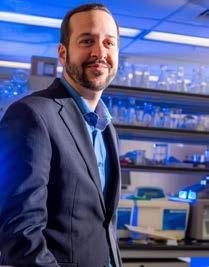
He has been working with researchers at the Institute for Basic Research in Developmental Disabilities (IBR), a New York State research entity based in Staten Island, to show that the immunotherapy can prevent and reduce Alzheimer’s-like changes in mice that have been genetically modified to develop a condition similar to Alzheimer’s. The team also collaborated with the Buffalo startup POP Biotechnologies, which was co-founded by Lovell, and universities and hospitals in Canada, Japan and Korea.
By Laurie Kaiser
Published September 9, 2024
Read the full article:
HWI, UB awarded $1.5 million grant for AI-assisted biomedical research
The U.S. Department of Energy awarded $1.5 million to a joint UB Hauptman-Woodward Medical Research Institute (UB-HWI) research project that will use artificial intelligence to study how cells and molecules respond to low doses of radiation.
Edward Snell, UB-HWI chief scientific officer, and Dominic Sellitto, clinical assistant professor of management science and systems, School of Management, serve as co-principal investigators on the research.
The project is part of the Low Dose Radiation Research program that supports research to develop disease risk prediction and understand its role in cancer, cardiovascular disease, neurological disorders, immune dysfunction and cataract formation, and, in the longer term, inform radiationprotection measures for the public and the workplace.
“Dr. Snell and his team have developed a method that targets different samples to analyze the biological impact of low doses of radiation, but these kinds of experiments are time-consuming and expensive, so that’s where AI comes in,” Sellitto explains. “As his team is refining those experiments, we’re also building a model that will go through all the data to create a lightweight, efficient AI you can just ask a question to, and it will accurately
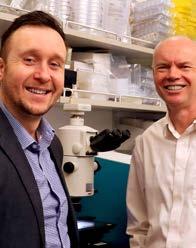
Dominic Sellitto
Clinical Assistant Professor, Management Science and Systems, Assistant Faculty Director, Center for AI Business Innovation, School of Management
Edward Snell, PhD
Professor, Department of Materials Design and Innovation, School of Engineering and Applied Sciences; Chief Scientific Officer and Director, BioXFEL, UB Hauptman-Woodward Medical Research Institute
predict what the experiment would have produced. The experimental component allows us to test and validate the computational predictions.”
Snell notes that leveraging the AI expertise of UB “allows us to develop a new tool for one area of health research that could have a dramatic impact across many health areas in the future.”
By Kevin Manne
Published September 3, 2024
Read the full article:
Patient Centered Outcomes Research Institute awards $1 million to UB researchers to use AI in analyzing social determinants of health
UB researcher Marianthi Markatou has received a funding award of more than $1 million from the Patient Centered Outcomes Research Institute (PCORI) to leverage artificial intelligence to integrate multiple data sources and develop statistical and computational methods for extracting knowledge from these data.
The potential impact of this work affects the management of multiple medical conditions, including opioid use disorder. The work also aims to develop novel methods for the analysis of social determinants of health.
The project will leverage large language models (LLMs), an extremely large type of artificial intelligence that is pre-trained on vast amounts of data, to extract diverse data—such as health care provider notes, discharge summaries, patient responses, blood pressure, weight and height—collected from opioid treatment programs.
“This research is an example of use-inspired research. That is, research that combines the development of scientific knowledge with the goal of creating solutions to solve societal and scientific challenges,” Markatou, the principal investigator on the project, explains. “A fundamental component of such research is the improvement and creative use of technology. In our context, large language models fulfill that role.”
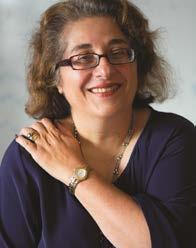
The interdisciplinary team of researchers will also develop analytic methods for identifying groups that are characterized by the same conditions.
“One of the objectives of our work is to reveal patterns in the data to identify novel social determinants of health, filling a methodological gap to permit analyses of mixed-type datasets and provide new methods to analyze clinical data,” Markatou says, adding that the team will develop and disseminate software solutions to implement the new methods.
By David J. Hill
Published December 10, 2024
Read the full article:



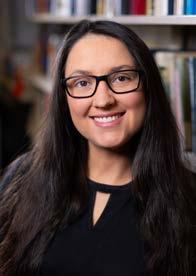
Our project’s goal is urgent, given the high levels of political polarization that have eroded national-level democratic norms and made it even more difficult for people to grapple with long-standing problems like poverty, racial segregation and xenophobia.
Alexandra Oprea, PhD
Assistant Professor, Department of Philosophy, College of Arts and Sciences
Photo: Douglas Levere
UB receives $500,000 Mellon grant to analyze immigration’s effects on local democratic norms
Faculty from UB’s Philosophy, Politics and Economics program received a $500,000 Mellon Foundation grant to study how inclusive immigration practices in Buffalo affect democracy at the local level.
The project explores whether new immigrants and refugees help create opportunities for democratic revival by focusing on communal spaces including Buffalo’s West Side Bazaar, Buffalo Museum of Science and local civic organizations.
Through interviews, focus groups and showcases, the team will gather firsthand perspectives to understand how democratic identities are shaped in everyday settings. The findings will offer insights for civic leaders and policymakers seeking to strengthen democracy through inclusion.
Highlights from an article by Bert Gambini
Published January 9, 2025
Read the full article:
Robert Wood Johnson Foundation funds UB project to build guidelines for promoting data equity for food equity
With $795,000 in funding from the Robert Wood Johnson Foundation, researchers at the University at Buffalo’s Food Systems Planning and Healthy Communities Lab (Food Lab) have launched a three-year project to explore how data equity can support food equity.
Through case studies and a virtual learning network, the team will investigate community food system dashboards and develop inclusive data guidelines that ensure better representation and outcomes for marginalized communities.
“Exploring the relationship of data equity to food equity is essential to uncovering systemic disparities and creating solutions that ensure everyone has access to nutritious, affordable food.”
Julia Czerniak, AIA Assoc., ASLA, RLA Dean and Professor, School of Architecture and Planning
Highlights from a release published by UB on January 28, 2025
Read the full release:
Study finds shared acoustic relationships among the world’s languages and music
A UB psychologist contributed to a global research study that identified three acoustic features— slower tempo, more stable pitch and higher pitch— that consistently distinguish song from speech across 55 languages and cultures.
This cross-cultural work provides insights into the evolution of language and music, supports the theory that music promotes social bonding and offers a model for more equitable and valid global research collaboration.
“There are many ways to look at the acoustic features of singing versus speaking, but we found the same three significant features across all the cultures we examined that distinguish song from speech.”
Peter Pfordresher, PhD
Professor and Associate Dean for Academic Affairs, Department of Psychology, College of Arts and Sciences
Highlights from an article by Bert Gambini
Published May 17, 2024
Read the full article:


Newly sequenced genome reveals coffee’s prehistoric origin story—and its future under climate change
A group of researchers co-led by UB have produced the highest-quality reference genome to date for Coffea arabica, the world’s most popular coffee species. Their findings, published in Nature Genetics, trace Arabica’s origin to a natural hybridization event over 600,000 years ago in Ethiopia. By sequencing 39 Arabica varieties, including historical specimens, the team uncovered insights into the crop’s evolution, genetic bottlenecks and climate-related population changes. This comprehensive genomic analysis identifies potential new paths for improving Arabica’s resistance to disease and climate stress, offering vital resources for preserving the future of a globally important crop.
“Our work has not been unlike reconstructing the family tree of a very important family.”
Victor Albert, PhD
Empire Innovation Professor, Department of Biological Sciences, College of Arts and Sciences
Highlights from an article written by Tom Dinki
Published April 16, 2024
Read the full article:
Why do we love carbs? Origins predate agriculture, maybe even our split from Neanderthals
A new study co-led by UB and the Jackson Laboratory reveals that humans began adapting to starch-rich diets more than 800,000 years ago through early duplications of the AMY1 gene, which produces salivary amylase to break down starch. Using advanced genome mapping and long-read sequencing, the researchers analyzed 68 ancient human genomes and found multiple AMY1 copies in hunter-gatherers long before agriculture. This genetic variation laid the foundation for today’s wide range of starch digestion abilities and may hold insights into metabolism, health and human evolution.
“The initial duplications in our genomes laid the groundwork for significant variation in the amylase region, allowing humans to adapt to shifting diets as starch consumption rose dramatically with the advent of new technologies and lifestyles.”
Omer Gokcumen, PhD Professor, Department of Biological Sciences, College of Arts and Sciences
Highlights from an article written by Tom Dinki
Published October 22, 2024
Read the full article:

Here, we can cross a new threshold. I believe that, in the next decade, we can situate UB in the Top 25 public research universities in the nation.
President Satish K. Tripathi
